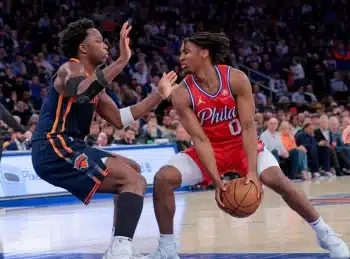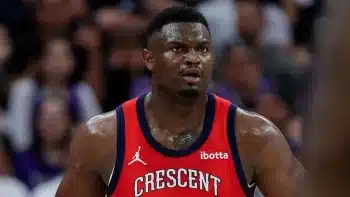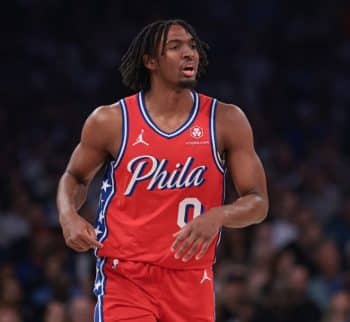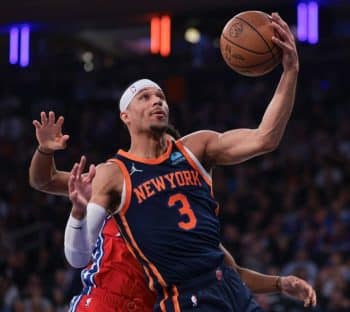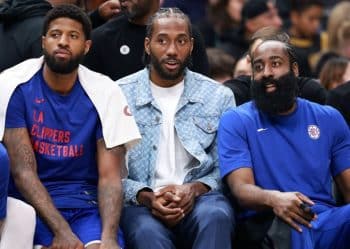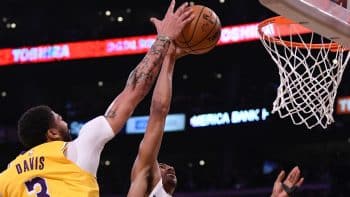NBA
NBA Daily: Chasing 40

As of this writing, James Harden is averaging 38.4 points per game.
Yes, 38.4.
He’s within striking distance of 40 – a number that would put him in the most rarified of air, joining Wilt Chamberlain as the only other player in NBA history to accomplish this feat.
Of course, Wilt averaged over 40 twice – 50.4 in 1961-62 and 44.8 in 1962-63. Harden has played 14 games. There’s a long way to go. But with each passing night, 40 looks more and more in reach.
And why not? He put up 36.1 per contest across 78 games last year. His partitioned game is like a filing system: Put threes there, rim attempts here and free throws in the back. Who says he can’t make one more three and one more free throw per game? He even started this year “slow,” getting 19 and 29 his first two out.
Since those two games, he’s scored under 30 twice. The other 11 games he’s been above 36. Even in today’s game, that’s unheard of – well, unless you’re James Harden.
Only two modern comparisons exist for what Harden’s doing the last 13 months: Michael Jordan in 1986-87 and Kobe Bryant in 2005-06. Jordan averaged 37.1. Kobe averaged 35.4 (for extra points, Rick Barry joins these four in the top-10 scoring seasons of all-time with 35.6 in 1966-67).
This year, Harden has a chance to go supernova — to really pass the Kobe season and to pass Jordan.
On any level, scoring points in the NBA is hard. But scoring at the rate these guys did requires two factors to blend seamlessly into a third. Talent has to meet opportunity in the right era. This equation was true of Wilt’s 50 and 44 seasons, and Jordan and Kobe’s 37 and 35, respectively.
It’s true of Harden’s 2019-20. And he might average 40 because of it.
—
Kobe, Jordan and Wilt are third, fifth, and seventh in scoring all-time. It’s no surprise they had outlier seasons (though Jordan went for 35 per game the year following 37.1). Harden is currently 55th, but will move into the top 35 or so by year’s end. There’s a good chance he breaks 30,000 career points in the next five years.
The truth is, Harden is as good of a scorer as they were. And he may even be better. Any argument to the contrary isn’t rooted in statistics or results – it’s rooted in a bias against Harden’s ways, or a distorted, reminiscent view of the past. A common refrain against Harden is that his scoring is a product of flopping and free throws – that without that, he wouldn’t be as effective.
Here’s Harden in 2012, still a member of the Thunder.
That looks pretty similar to what he does now — the paced attack; the ball-out, arms-locked attack to incite fouls; the strength to finish anyway.
And here he is the following season, his first as a Rocket.
Copy and paste that into game film from today, and no one notices the difference.
He’s been doing this his whole career…he’s just leveraged his ability with opportunity in the right era to become the most dominant isolation player of the last decade.
Opportunity arises in part because of talent. It’s also borne of team and organizational needs. When Jordan scored 37.1, he was coming off a broken foot and an 18-game season. The 1986-87 campaign saw the Bulls go 40-42, with only three players scoring over 10 per game. Charles Oakley and John Paxson joined Jordan in double figures, with the fourth-highest scorer being Gene Banks at 9.7. Only 8 of the 17 players from ‘86-87 returned the following year.
Charles Oakley scored 9.7 points per game for his career. Paxson scored 7.2. Those were Chicago’s second and third options – with Jordan’s skill level, he had one of the greatest opportunities of all time to put up huge numbers.
In 2005-06, the proud Los Angeles Lakers were on the heels of a 34-48 record and missed the postseason in their first year after Shaquille O’Neal. They entered ’05-06 with Lamar Odom as the only player outside Kobe able to create offense (To our frustration, Smush Parker was as disappointing as we remember him.).
Kobe was all LA had – he obliged by taking 27 shots per game and leading the league in scoring.
Generational, ball-dominant perimeter talents anchoring otherwise average to below-average rosters equal the recipe for lots and lots of points.
That’s where Harden has found himself in Houston, this year more than ever.
Since the now-infamous Thunder deal, Harden is averaging 29 points per game. He’s on his way to his third straight 30-point-per-game season, and second above 35. His numbers have continued to climb not only due to individual improvement, but also within his permanent place as the unquestioned center of the offense. This is the collection of point guards Harden’s seen during his Houston tenure:
Jeremy Lin, Patrick Beverley, Aaron Brooks, Ty Lawson, Chris Paul.
The latter four were far from central playmakers – Paul was the only other star Harden’s joined forces with, and even he declined significantly last season. Sidenote: We’re also not counting the failed Dwight Howard experiment. While other teams were doubling and tripling down on star-laden rosters, Harden was primarily left as the single-engine to the Rockets’ vehicle. He had no choice but to make all the decisions.
This becomes even more true with Paul gone. Paul and Harden have similar styles in that they both control the ball. Consequently, even with the two often playing staggered minutes, Harden’s opportunities decreased. Paul took some of the slowed-down possessions away from him.
The fit with Russell Westbrook, however, is more complementary. Westbrook has Houston playing at the fastest pace in the NBA. He gets it and goes. When he doesn’t have it in transition, he pulls back and gives it to Harden. Harden isn’t losing those prodding isolation possessions anymore.
As Harden has improved year-by-year, he’s done it amid a changing NBA. His rise has coincided with the three-point boom – and it’s led to the possibility of a 40-point-per-game season.
—
In 1986, Michael Jordan was doing things on a basketball court that few had ever seen.
The ability to leap and hang in the air wasn’t common then. The clip below encapsulates Jordan’s 37.1 ppg season:
Look at that spacing! Jordan clunkily misses a jumper over a double-team, gets the ball back and makes a play at the basket. He scored because he was more athletic than everyone else. That’s not an indictment on Jordan, and he didn’t only score this way – he was skilled this early in his career, too. But the athleticism was the predominant thing. Just check out this clip from 1988:
(1988) Jordan breaks out a wrap around dribble to his same hand and the commentators go crazy.
"I can't explain what he just did." pic.twitter.com/iv2KSTKLRK
— Timeless Sports (@timelesssports_) August 14, 2019
You’d have thought MJ was a Salem Witch the way the announcers reacted to a behind-the-back dribble. Imagine if they saw Kyrie back then!
Jordan was unparalleled in talent over the history of the NBA; this was especially true, athletically, in 1986. That, along with the state of the Bulls’ roster, mightily contributed to his single-season top-five scoring average.
Kobe Bryant took 2,173 shots in 2005-06. Of those, 1,655 were two-pointers. And of those two-pointers, 1,041 were taken between 10 feet and the three-point line. Kobe took 27 shots per game and 13 of them were long twos. Think about that: Kobe spent an entire NBA season not only shooting 27 times a night, but taking the least efficient shot in basketball nearly half the time.
(Quick aside: Jordan took 27.8 shots per game in ’86-87. Wilt took 34.6 shots per game in his 44-point season and 39.5 shots per game in his 50-point season. So, when Harden scores 49 on 41 shots as he did in Minnesota last week, please don’t complain while standing up for the other three.)
The league’s climate in ’05-06 was perfect for Bryant to hoist an inordinate amount of mid-range shots. 79.8 percent of the league’s field goal attempts came from two-point range, compared to 62.5 percent this year — Harden’s Rockets are at 49.4 percent. Kobe’s greatest strength was the NBA’s most popular shot, and he took advantage.
That brings us to Harden. If Harden followed Steph Curry’s lead and broke basketball last season, he’s slammed into a million pieces in 2019-20.
Harden set a record last year by attempting 1,028 threes, making up over half of his total field goal attempts. That averages out to 13.2 per night – and most of those were unassisted. His shooting percentage of 61.6 was otherworldly, considering the difficulty of his looks.
Now, he’s back for an encore.
His shot chart is more categorized than ever. 56 percent of his attempts are threes, up slightly from last season. 21 percent come at the rim, and almost 20 come from 3-10 feet – and if you watch, most in the 3-10 range are short floaters. Only 2.9 percent of Harden’s looks are between 10 feet and the three-point line.
He’s taking 13.9 three-point attempts per game. Before last night’s loss in Denver, he’d already taken 200 threes!
His total shot attempts per game are at 25.4 (lower than Wilt, Jordan and Kobe during their historic seasons) and he’s taking 14.5 free throws per game. If you threw twos out the window, Harden would get you 28 points on threes and free throws alone!
The free throw rate should slightly regress. He took 11 per game last year and should stay in that 11-12 range. But his shooting percentages are down; he’s shooting 42.5 from the field and 34 from three, about two percentage points lower than his Houston norms. Assuming those tick back up, there’s no reason to believe he can’t add a few points per game to break 40.
—
Averaging 40 is next to impossible. Only one person has ever done it – and he did it towering over the league, on 39.5 and 34.6 shots each night, at a breakneck pace. Jordan, Kobe and Harden are the only players in the last 30 years or so to even sniff it.
Harden is at the peak of his powers. He plays with a team that relies on him to be the offense and a star running mate whose game doesn’t clash with his. He’s reached the heights of his game at the summit of the three-ball movement, where shot distribution and efficiency are king.
He still has to prove it can work in the playoffs. And even if he can’t, maybe that’s okay. Maybe, among the detractors whining about his style, complaining about his methods, we should enjoy this for what it is: an all-time scorer tearing through the league.
Jordan had a funny quote about his 37.1-point season that went something like this: It was hard, because he’d score 32 one night and then realize, man, I have to get 42 tomorrow to stay on track.
Harden had 27 last night. He’d need 53 Friday to keep the pace.
It’s kind of ridiculous when you think about it that way. Still, it seems unwise to bet against him.
